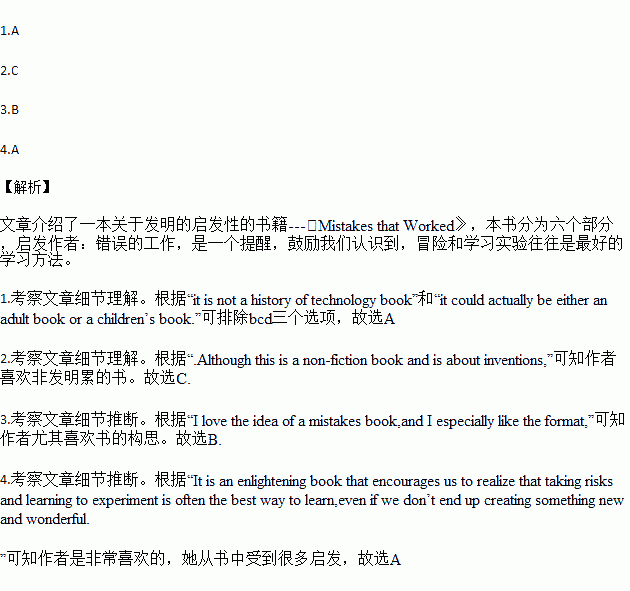题目内容
Ever wonder where chocolate chip cookies came from?Or why we use waffles(华夫饼)as ice cream cones?
Mistakes that Worked,written by Charlotte Foltz Jones,award-winning author of non-fiction books for children, offers forty of these unusual tales,along with many interesting drawings and strange and amazing facts.
The book is divided into six parts: food,medicine,toys,accidental things,names,and I find the book great because if not for the book,I would never have known that something was actually accidentally created.Besides,I like to learn real information;I can't stand books with stories that aren't real.Although this is a non-fiction book and is about inventions,it is not a history of technology book;it's more of an easy reading book.This book would be attractive to both boys and girls,and it could actually be either an adult book or a children’s book.
Published in 1991,the book is a bit old and is showing its age now in 2016.Still,it contains lots of great information,even though some facts are not exact.I love the idea of a mistakes book,and I especially like the format, which allows readers to dip in and out of the book easily.However,the entries are not all equally strong. Additionally, if you don’t live in the US,the book makes little sense,since it is full of American references both historically and in terms of customs.
Anyway,Mistakes that Worked is a reminder that failure is not always the end.It is an enlightening book that encourages us to realize that taking risks and learning to experiment is often the best way to learn,even if we don’t end up creating something new and wonderful.
1.What kind of book is Mistakes that Worked?
A. It's a picture book. B. It's a science book.
C. It's an adult book. D. It's a historical book.
2.What can we infer about the author?
A. He reads too little.
B. He is a slow reader.
C. He is a great reader of non-fiction.
D. He enjoys reading books about inventions.
3.Which of the following does the author especially like about the book?
A. Its facts. B. Its organization.
C. Its entries. D. Its reference.
4.What is the author's opinion on the book?
A. It's a fun read. B. It's a perfect book.
C. It makes little sense. D. It's full of factual mistake

